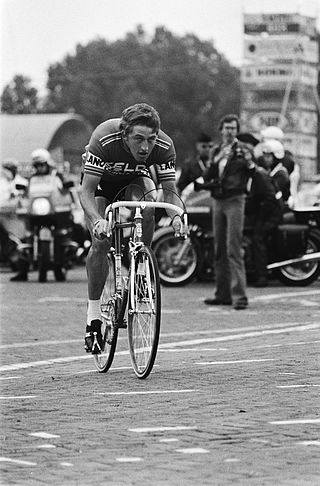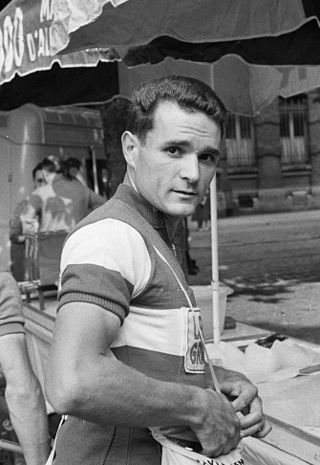
Raymond Poulidor, nicknamed "Pou-Pou", was a French professional racing cyclist, who rode for Mercier his entire career.

Angelo Fausto Coppi was an Italian cyclist, the dominant international cyclist of the years after the Second World War. His successes earned him the title Il Campionissimo. He was an all-round racing cyclist: he excelled in both climbing and time trialing, and was also a good sprinter. He won the Giro d'Italia five times, the Tour de France twice, and the World Championship in 1953. Other notable results include winning the Giro di Lombardia five times, the Milan–San Remo three times, as well as wins at Paris–Roubaix and La Flèche Wallonne and setting the hour record (45.798 km) in 1942.

Jacques Anquetil was a French road racing cyclist and the first cyclist to win the Tour de France five times, in 1957 and from 1961 to 1964.

Richard Virenque is a retired French professional road racing cyclist. He was one of the most popular French riders with fans for his boyish personality and his long, lone attacks. He was a climber, best remembered for winning the King of the Mountains competition of the Tour de France a record seven times, but he is best known from the general French public as one of the central figures in a widespread doping scandal in 1998, the Festina Affair, and for repeatedly denying his involvement despite damning evidence.

Thomas Simpson was one of Britain's most successful professional cyclists. He was born in Haswell, County Durham, and later moved to Harworth, Nottinghamshire. Simpson began road cycling as a teenager before taking up track cycling, specialising in pursuit races. He won a bronze medal for track cycling at the 1956 Summer Olympics and a silver at the 1958 British Empire and Commonwealth Games.

In road bicycle racing, a domestique is a rider who works for the benefit of their team and leader, rather than trying to win the race. In French, domestique translates as "servant". The use of the term dates back to 1911, although such riders had existed before then.

Rudi Altig was a German professional track and road racing cyclist who won the 1962 Vuelta a España and the world championship in 1966. After his retirement from sports he worked as a television commentator.

Henri "Rik" Van Looy is a Belgian former professional cyclist of the post-war period. Nicknamed the King of the Classics or Emperor of Herentals, he dominated the classic cycle races in the late 1950s and first half of the ‘60s.

Charly Gaul was a Luxembourgish professional cyclist. He was a national cyclo-cross champion, an accomplished time triallist and superb climber. His ability earned him the nickname of Angel of the Mountains in the 1958 Tour de France, which he won with four stage victories. He also won the Giro d'Italia in 1956 and 1959. Gaul rode best in cold, wet weather. In later life, he became a recluse and lost much of his memory.

Freddy Maertens is a Belgian former professional racing cyclist who was twice world road race champion. His career coincided with the best years of another Belgian rider, Eddy Merckx, and supporters and reporters were split over who was better. Maertens' career swung between winning more than 50 races in a season to winning almost none and then back again. His life has been marked by debt and alcoholism. It took him more than two decades to pay a tax debt. At one point early in his career, between the 1976 Tour and 1977 Giro, Maertens won 28 out of 60 Grand Tour stages that he entered before abandoning the Giro due to injury on stage 8b. Eight Tour stage wins, thirteen Vuelta stage wins and seven Giro stage wins in less than one calendar year.

The 1962 Tour de France was the 49th edition of the Tour de France, one of cycling's Grand Tours. The 4,274-kilometre (2,656 mi) race consisted of 22 stages, including two split stages, starting in Nancy on 24 June and finishing at the Parc des Princes in Paris on 15 July. There were four time trial stages and no rest days. After more than 30 years, the Tour was again contested by trade teams instead of national teams. Jacques Anquetil of the Saint-Raphaël–Helyett–Hutchinson team won the overall general classification, defending his title to win his third Tour de France. Jef Planckaert (Flandria–Faema–Clément) placed second, 4 min 59 s in arrears, and Raymond Poulidor (Mercier–BP–Hutchinson) was third, over ten minutes behind Anquetil.

Johannes Adrianus "Jan" Janssen is a Dutch former professional cyclist (1962–1972). He was world champion and winner of the Tour de France and the Vuelta a España, the first Dutch rider to win either. He rode the Tour de France eight times and finished all but the first time. He won seven stages and wore the yellow jersey for two days. He was easily spotted in the peloton because of his blond hair and his glasses. As of the death of Federico Bahamontes in August 2023, he is the oldest surviving winner of the Tour de France.

Raphaël Géminiani is a French former road bicycle racer. He had six podium finishes in the Grand Tours. He is one of four children of Italian immigrants who moved to Clermont-Ferrand fleeing from fascist violence. He worked in a cycle shop and started racing as a boy. He became a professional and then a directeur sportif, notably of Jacques Anquetil and the St-Raphaël team.

Seamus "Shay" Elliott was an Irish road bicycle racer, Ireland's first major international rider, with a record comparable only to Sean Kelly and Stephen Roche. He was the first Irish person to ride the Tour de France, first to win a stage, and first to wear the yellow jersey, and first English speaker to win stages in all the Grand Tours.

Henry Anglade was a French cyclist. In 1959 he was closest to winning the Tour de France, when he won a stage and finished second, 4:01 behind Federico Bahamontes. In 1960 he wore the yellow jersey for two days while finishing 8th overall. He placed in the top five of the Tour on two additional occasions in 1964 and 1965.
The 1959 Giro d'Italia was the 42nd running of the Giro d'Italia, one of cycling's Grand Tour races. The Giro started in Milan, on 16 May, with a 135 km (83.9 mi) stage and concluded back in Milan, on 7 June, with a 220 km (136.7 mi) leg. A total of 120 riders from 15 teams entered the 20-stage race, which was won by Luxembourgian Charly Gaul of the EMI team. The second and third places were taken by Frenchman Jacques Anquetil and Italian Diego Ronchini, respectively.
Arthur Metcalfe was a British racing cyclist who twice rode the Tour de France and, as an amateur remains the only male rider to win the British road race championship and the British Best All-Rounder (BBAR) time trial competition in the same year.
Dave Bedwell was one of Great Britain's most accomplished racing cyclists in the 1950s, known as the "Iron Man" of cycling. He won four stages in the first Tour of Britain, rode for Britain in the world professional road championship in 1953 and 1956 and rode for Britain in the Tour de France.
Alan Ramsbottom was a professional racing cyclist from Clayton-le-Moors, England, who twice rode the Tour de France.
Les West was one of the dominant figures of amateur and professional cycling in Britain during the 1960 and 1970s. He won the Milk Race twice, came second in the world amateur road race championship and fourth in the world professional championship.
















